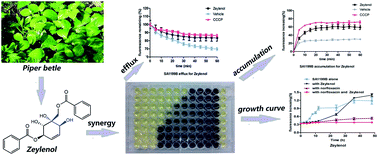This research seeks to address the problem of methicillin-resistant Staphylococcus aureus (MRSA) by discovering synergistic antibacterial natural substances from traditional Chinese herbs using antibacterial bioassays. Six compounds, including three neolignans (−)-acuminatin (1), (−)-denudatin B (2), puberulin D (3), and three benzocyclohexane oxide derivatives ferrudiol (4), ellipeiopsol B (5) and zeylenol (6), were isolated and purified by silica gel and reverse-phase silica gel column chromatography, and the chemical structures were determined through NMR spectroscopy, MS, together with CD and calculated CD spectroscopic methods. Synergistic activity was determined using strain SA1199B, a strain that overexpresses the major S. aureus multidrug transporter, NorA. Compounds 1–6 showed synergistic activity combined with norfloxacin against SA1199B, with FICI values of 0.13, 0.25, 0.25, 0.52, 0.08 and 0.27 respectively. The synergistic effects of the benzocyclohexane oxide derivatives with norfloxacin were further demonstrated through strain growth kinetics experiments. In the mechanistic experiment, the compounds showed significant accumulation and/or inhibition effects for EtBr efflux in SA1199B. These active compounds showed no toxicity to HEK293T cells at a concentration of 100 μM in the cytotoxicity evaluation experiments. Combined with efflux pump inhibitors, classic antibiotics that are substrates for efflux pumps may yet play a role in the therapy of drug-resistant bacteria where a lower dose could result in improved safety.

